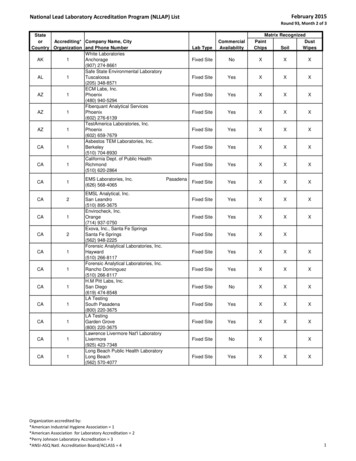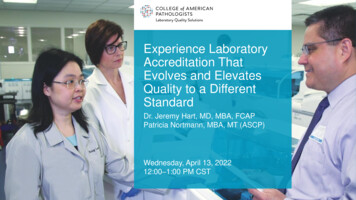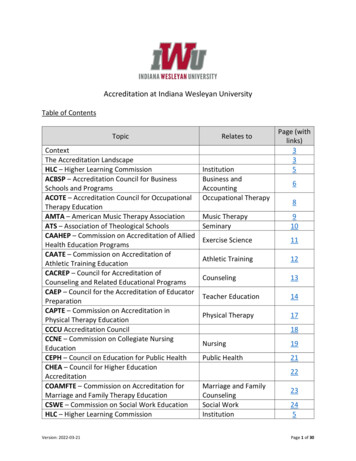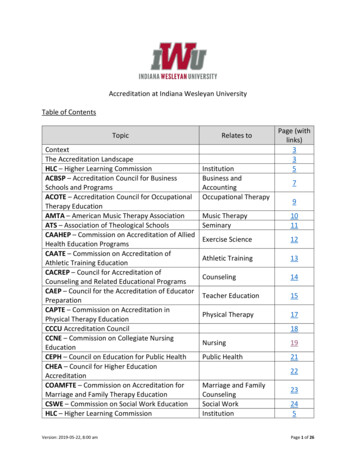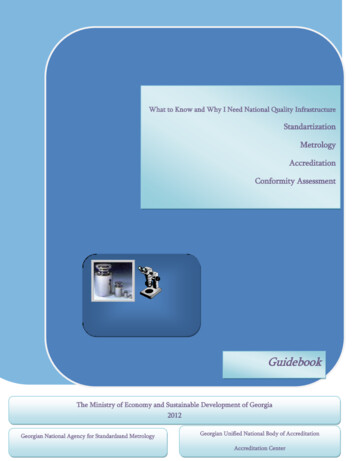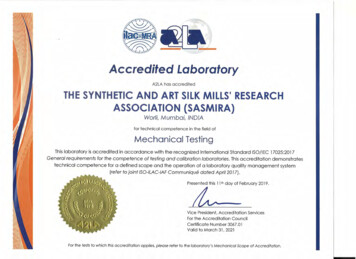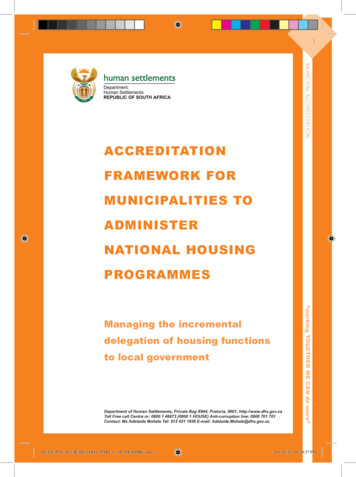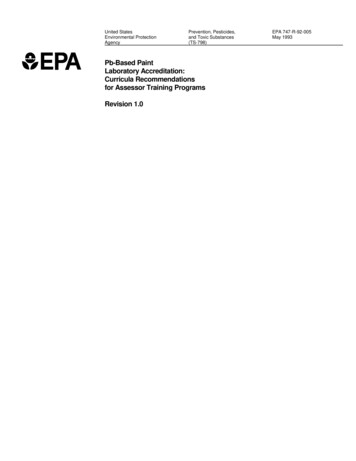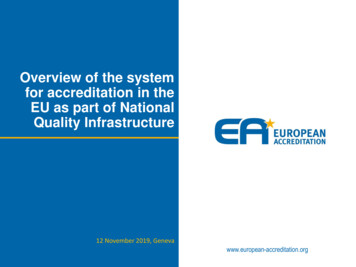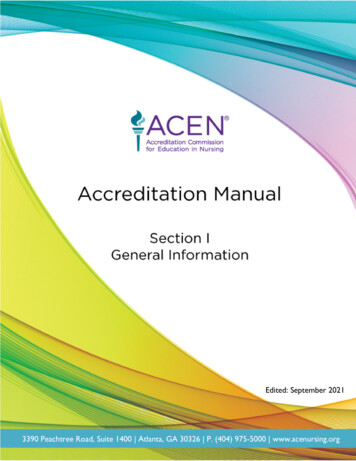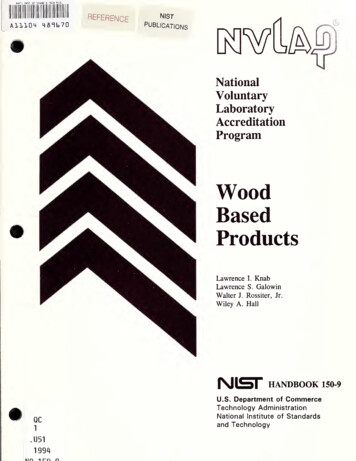
Transcription
enceLawrenceWalter J.Wiley A.I. KnabS. GalowinRossiter, Jr.HallNISTHANDBOOK 150-9U.S. Department of CommerceTechnology AdministrationNational Institute of Standardsand TechnologyQC1.11511994nm-i rnn
m-M-he National Institute of Standards and Technology was established in 1988 by Congress to “assist industryin the development of technology . needed to improve product quality, to modernize manufacturing processes,to ensure product reliability . . . and to facilitate rapid commercialization . of products based on new scientificdiscoveries.”NIST, originally founded as the National Bureau of Standards in 1901, works to strengthen U.S. industry’scompetitiveness; advance science and engineering; and improve public health, safety, and the environment. One of theagency’s basic functions is to develop, maintain, and retain custody of the national standards of measurement, andprovide the means and methods for comparing standards used in science, engineering, manufacturing, commerce,industry, and education with the standards adopted or recognized by the Federal Government.As an agency of the U.S. Commerce Department’s Technology Administration, NIST conducts basic and appliedresearch in the physical sciences and engineering, and develops measurement techniques, test methods, standards, andrelated services. The Institute does generic and precompetitive work on new and advanced technologies. NIST’sresearch facilities are located at Gaithersburg, MD 20899, and at Boulder, CO 80303. Major technical operating unitsand their principal activities are listed below. For more information contact the Public Inquiries Desk, 301-975-3058.Office of the DirectorManufacturing Engineering Laboratory Advanced Technology Program Quality Programs Precision Engineering Automated Production Technology International and Academic Affairs Intelligent Systems Manufacturing Systems Integration Fabrication TechnologyTechnology Services Manufacturing Extension PartnershipStandards ServicesTechnology CommercializationMeasurement Services Technology Evaluation and Assessment Information ServicesMaterials Science and EngineeringLaboratory Intelligent Processing of MaterialsCeramicsMaterials Reliability1PolymersMetallurgy Reactor RadiationChemical Science and TechnologyLaboratoryElectronics and Electrical EngineeringLaboratory Microelectronics Law Enforcement Standards Electricity Semiconductor Electronics Electromagnetic Fields' Electromagnetic Technology' Optoelectronics'Building and Fire Research Laboratory Structures Building Materials Building Environment Fire Safety Fire Science BiotechnologyComputer Systems Laboratory Chemical Kinetics and Thermodynamics Analytical Chemical Research Office of Enterprise Integration Information Systems Engineering Systems and Software Technology Process Measurements2 Surface and Microanalysis Science Thermophysics2 Computer Security Systems and Network Architecture Advanced SystemsPhysics Laboratory Electron and Optical Physics Atomic Physics Molecular PhysicsComputing and Applied MathematicsLaboratory Applied and Computational Mathematics2 Radiometric Physics Quantum Metrology Ionizing Radiation Statistical Engineering2 Time and Frequency1 Quantum Physics' Computer Systems and Communications2 Information Systems'At Boulder, CO 80303.2Some elements at Boulder, CO 80303. Scientific Computing Environments2 Computer Services2
NIST HANDBOOK amWoodBasedProductsLawrence I. Knab, NISTLawrence S. Galowin, NISTWalter J. Rossiter, Jr., NISTWiley A. Hall (retired), NISTNovember 1994U.S. Department of CommerceRonald H. Brown, SecretaryTechnology AdministrationMary L. Good, Under Secretary for TechnologyNational Institute of Standards and TechnologyArati Prabhakar, Director
National Institute of Standards and TechnologyNIST Handbook 150-972 pages (November 1994)CODEN: NIHAE2U.S. GOVERNMENT PRINTING OFFICEWASHINGTON: 1994For sale by the Superintendent of DocumentsU.S. Government Printing OfficeWashington, DC 20402-9325NVLAP AND THE NVLAP LOGOThe term NVLAP and the NVLAP logo areFederally registered trademarks of the NationalInstitute of Standards and Technology and theFederal Government, who retain exclusive rightstherein. Permission to use the term and/or the logois granted to NVLAP-accredited laboratories for thelimited purposes of announcing their accreditedstatus, and for use on reports that describe onlytesting and calibration within the scope ofaccreditation. NIST reserves the right to controlthe quality of the use of the term NVLAP and ofthe logo itself.
PREFACENIST Handbook 150-9 presents the technical requirements of the National Voluntary LaboratoryAccreditation Program (NVLAP) for the Wood Based Products (WBP) field of accreditation. It isintended for information and use by staff of accredited laboratories, those laboratories seekingaccreditation, other laboratory accreditation systems, users of laboratory services, and others needinginformation on the requirements for accreditation under the WBP program.This publication supplements NIST Handbook 150, NVLAP Procedures and General Requirements, whichcontains Part 285 of Title 15 of the U.S. Code of Federal Regulations (CFR) plus all general NVLAPprocedures, criteria, and policies. The criteria in NIST Handbook 150 encompass the requirements ofISO/IEC Guide 25 and the relevant requirements of ISO 9002 (ANSI/ASQC Q92-1987). Handbook150-9 contains information that is specific to the WBP program and does not duplicate informationcontained in the Procedures and General Requirements. The numbering of the sections of this handbookis patterned after Handbook 150; for example. Section 285.3 of Handbook 150 presents the descriptionand goal of NVLAP, whereas Section 285.3 of Handbook 150-9 presents the description of the WBPprogram. Where there is no material specific to the field of accreditation, the section number is omitted.NIST policy requires SI units; however, when trade practices use customary units, such as with the woodbased products industry, customary units are preferred and are used in this report.Any questions or comments on this handbook should be submitted to the National Institute of Standardsand Technology/NVLAP, Building 411, Room A162, Gaithersburg, MD 20899; phone (301) 975-4016;FAX (301) 926-2884.
ACKNOWLEDGMENTSThe technical requirements for the Wood Based Products (WBP) Program in this handbook weredeveloped in cooperation with the U. S. Department of Agriculture - Forest Service - Forest ProductsLaboratory (FPL). FPL assisted NYLAP by providing technical support and general consultation. FPLstaff hosted a number of meetings at which the technical requirements for the WBP Program werereviewed and discussed by government and industry representatives. The assistance of FPL staffmembers, J. Dobbin McNatt, Russell Moody, Joe Murphy, George Myers, Bryan River, and ErwinSchaffer, is greatly appreciated.Erwin Schaffer is especially acknowledged for his efforts,encouragement, and guidance given to the WBP Program. The authors also express their appreciationto the specialists from a number of industries and trade associations for their voluntary participation insuggesting and reviewing the technical requirements proposed for the program.The authors gratefully acknowledge Vanda White, and Charming Monti of NVLAP for their editing,revising, and final publishing of the handbook.
TABLE OF . 285.1 Purpose.1Sec. 285.2 Organization of procedures.1Sec. 285.3 Description of Wood Based Products program.1Sec. 285.4 References.1Sec. 285.5 Definitions.2Sec. 285.6 NVLAP documentation.3Sec. 285.22 Assessing and evaluating a laboratory.4.6Sec. 285.33 Criteria for accreditation .(c)Quality system, audit and review .(d)Personnel.(f)Equipment and reference materials .(g)Measurement traceability and calibration .(h)Calibration and test methods.(j)Records.(k)Certificates and reports .(m)Outside support services and supplies .66788991010Sec. 285.23 Granting and renewing accreditationAPPENDICESSAMPLE ACCREDITATION DOCUMENTS.GENERAL OPERATIONS CHECKLIST.SPECIFIC OPERATIONS CHECKLIST .TEST METHOD SELECTION LIST .CRITICAL ELEMENTS .ON-SITE ASSESSMENT - TEST METHOD REVIEW.vA-lB-lC-lD-lE-lF-l
SUMMARYAny laboratory (including commercial, manufacturer, university, or federal, state, or local governmentlaboratory) that tests in accordance with the applicable standard test methods may apply for NVLAPaccreditation in the Wood Based Products (WBP) program. Accreditation will be granted to a laboratorythat satisfactorily meets the conditions for accreditation defined in the NIST Handbook 150, NVLAPProcedures and General Requirements, which contains Title 15, Part 285 of the Code of FederalRegulations.These conditions include satisfactory performance in selected proficiency testing asrequired, and fulfilling the on-site assessment requirements, including resolution of identified deficiencies.The names of NVLAP-accredited laboratories are published in the NVLAP annual directory and othermedia to which information is regularly provided.Test services covered: The scope of the WBP program covers standard test methods for wood basedproducts given in the Test Method Selection List (Appendix D).Period of accreditation: One year, renewable annually.On-site assessment: Visit by a technical expert to determine compliance with the NVLAP criteria beforeinitial accreditation and every two years thereafter. Additional monitoring visits as required.Assessors: Technical experts with experience in the appropriate fields of testing.Proficiency Testing: NVLAP will perform proficiency testing when sufficient laboratories have enrolledsuch that it is economically feasible. Each laboratory will be required to test and analyzeproficiency testing sample material(s) for specific test methods. Proficiency testing will beconducted semiannually.Advance notice and instructions will be given before testing isscheduled. The completed test data report will be sent to NVLAP or, as directed, to theproficiency testing contractor. A summary of results will be sent to the participants.Granting Accreditation: Based upon satisfactory on-site assessment and resolution of deficiencies,proficiency testing, and technical evaluation of applicable laboratory information.Fees: Payments are required as listed on the fee schedule, including the administrative/technical supportfee, on-site assessment fee, proficiency testing fee, and test method fee.vi
Sec. 285.1 PurposeSec. 285.3 Description of Wood Based ProductsprogramThe purpose of this handbook is to set out proceduresand technical requirements for NVLAP accreditationof laboratories which perform test methods coveredThe NVLAP program for Wood Based Productsprovides for laboratory accreditation to assure thatstandard test procedures for chemical, physical,mechanical, fire performance, formaldehyde, andtreated-wood characteristics are followed when testingby the Wood Based Products (WBP) program. ItcomplementsandsupplementstheNVLAPprogrammatic procedures and general requirementsfound in NIST Handbook 150.The interpretivewood based products.The WBP program usesstandard test methods as shown in Appendix D fromthe American Institute of Timber Constructioncomments and additional requirements contained inthis handbook make the general NVLAP criteriaspecifically applicable to the WBP program. Thequality system requirements are designed to complywith the requirements of ISO/IEC Guide 25 and the(AITC), American National Standards Institute(ANSI), American Plywood Association (APA),American Society for Testing and Materials (ASTM),American Wood Preservers’ Association (AWPA),Canadian Standards Association (CSA), Europeanrelevant requirements of ISO 9002.Sec. 285.2 Organization of proceduresCommittee for Standardization (CEN), HardwoodPlywood and Veneer Association (HPVA), National(a)Institute of Standards and Technology (NIST), andthe National Particleboard Association (NPA).The procedures described in this handbook areorganized to cross-reference with NIST Handbook150, NVLAP Procedures and General Requirements.The WBP program was developed in response to a(b)Inaddition,thehandbookcontainssixrequest made in 1992 by the APA and subsequentlysupported by the NPA, and U.S. Department ofappendices:Certificate of Accreditation and a Scope ofHousing and Urban Development (HUD). The lettersrequesting the development of the program indicatedthe importance of international acceptance andAccreditation for the WBP program;reciprocity for the program in laboratory accreditation(1)AppendixA provides examplesof ato promote international trade.(2)AppendixBprovidestheGeneralSec. 285.4 ReferencesOperations Checklist, which NVLAP assessorsuse during an on-site technical assessment toevaluate a laboratory’s ability to conduct testing(a) The following documents are referenced or citedin this handbook:in general;(3) AppendixC providestheSpecificOperations Checklist, which NVLAP assessorsuse during an on-site technical assessment of a(1) ISO/IEC Guide 25, General Requirementsfor the Competence of Calibration and TestingLaboratories,andISO9002,Qualitylaboratory that tests the performance propertiesof wood based products;Systems—Model for Quality Assurance inProduction and Installation; available from:(4) Appendix D lists the standard test methodsand their accompanying NVLAP Codes for theAmerican(ANSI)WBP program as given on the NVLAP TestMethod Selection List;11 West 42 Street, 13th FloorNew York, NY 10036(5)Order Phone:Appendix E gives a description of a criticalelement summary as used by NVLAP assessorsduring an on-site technical assessment; andOrder Fax:NationalStandardsInstitute(212) 642-4900(212) 302-1286;(6) Appendix F provides the sheets that theassessor completes in conducting a test methodreview.NIST Handbook 150-91November 1994
(2) NIST Handbook 150, NVLAP Proceduresand General Requirements', available from:(6)NIST/NVLAPBuilding 411, Room A162Gaithersburg, MD 20899Canadian Standards Association (CSA)178 Rexdale Blvd.Rexdale, OntarioM9W 1R3CANADAPhone: (416) 747-4104FAX: (410) 747-2575;Phone: (301) 975-4016Order Fax: (301) 926-2884.(7)(b) The most recent publication of the standard(s)for the test method(s) for which the laboratory isaccredited shall be available as reference(s). For theWBP program, these standards are listed inAppendix D and can be obtained from:European Committee for Standardization,Brussels, Belgium(CEN Standards are available from ANSI,International Publications, at address listedin (a) above.)Order Phone:(1)(212) 642-4995;American Institute of Timber Construction(AITC)(8)7012 S. Revere Parkway, Suite 140Englewood, CO 80112HardwoodPlywoodAssociationP. O. Box 2789andVeneerReston, VA 22090Phone: (303) 792-9559FAX: (303) 792-0669;Phone: (703) 435-2900FAX: (703) 435-2537;(2)ANSI (see (a) above);(3)American Plywood Association (APA)P. O. Box 11700Tacoma, WA 98411-0700(9)Phone: (301) 975-4025FAX: (301) 963-2871;Phone: (206) 565-6600FAX: (206) 565-7265;(4)AmericanSocietyMaterials (ASTM)1916 Race StreetforTesting(10) National Particleboard Association18928 Premiere CourtGaithersburg, MD 20879andPhiladelphia, PA 19103-1187(5)NIST/Standards Management ProgramAdministration Building, Room A625Gaithersburg, MD 20899Phone: (301) 670-0604FAX: (301) 840-1252.Phone: (215) 299-5400FAX: (215) 977-9679;Sec. 285.5 DefinitionsAmerican Wood-Preservers’ Association(AWPA)Composite panel: A veneer-faced panel with areconstituted wood core. The flakeboard core mayP. O. Box 286be random or have alignment in the direction 90 Woodstock, MD 21163-0286from the grain direction of the veneer faces.Phone: (410) 465-3169FAX: (410) 465-3195;Critical elements: A compilation of summarystatements of the key provisions of a standard testmethod that guides assessors in applying a commonobjective assessment of a laboratory’s ability toconduct tests.Glued-laminated timbers (giulam): Two or morelayers of wood glued together with the grain of alllayers or laminations approximately parallel.NIST Handbook 150-92November 1994
Laminated veneer lumber (LVL): A structurallumber manufactured from veneers laminated into apanel with the grain of all veneer running parallel toeach other.The resulting panel is normallymanufactured in 3/4- to 1-1/2-inch thicknesses andQuality control: The operational techniques andactivities that are used to fulfill requirements forquality.Structural sandwich construction: A layeredconstruction comprising a combination of relativelyhigh-strength facing materials intimately bonded toand acting integrally with a low-density core material.ripped to common lumber widths of 1-1/2 to 11-1/2inches, or wider (see statement in Preface on NISTpolicy with regard to use of SI units).Medium-density fiberboard (MDF): A panelproduct manufactured from lignocellulosic fiberscombined with a synthetic resin or other suitableStructural-use panel: A panel product composedprimarily of wood which, in its commodity end use,is essentially dependent upon certain mechanicaland/or physical properties for successful end-useperformance.binder. The panels are manufactured to a density of31 pcf (0.50 specific gravity) to 55 pcf (0.88 specificgravity) by the application of heat and pressure by aTreatprocess in which the interfiber bond is substantiallycreated by the added binder. Other materials mayhave been added during manufacturing to improvecertain properties.(verb):To applya preservativeor fireretardant to wood.- Wood Preservation: The art of protectingtimber against the action of destructive agents.Oriented strand board: A type of particle panelproduct composed of strand-type flakes which areUsually refers to the treatment of wood withchemical substances (preservatives) whichreduce its susceptibility to deterioration bypurposefully aligned in directions which make a panelstronger, stiffer, and with improved dimensionalfungi, insects, or marine borers.properties in the alignment directions than a panelwith random flake orientation.- Treatment, Fire-Retardant:Treatment ofwood under pressure with chemicals to reduceParticleboard: A generic term for a materialmanufactured from wood particles or other ligno cellulosic material and a synthetic resin or otherits flame spread, fuel contribution, and smokedevelopment.Waferboard:suitable binder.A particle panel product made ofwafer-type flakes, usually manufactured to possessPlywood: A glued wood panel made up of relativelythin layers of veneer with the grain of adjacent layersequal properties in all directions parallel to the planeof the panel.at right angles, or of veneer in combination with acore of lumber or of reconstituted wood.(SeeWood based products: Broad term for manufacturedComposite panel.) The usual constructions have anwood products, including particleboard,odd number of layers.density fiberboard, structural use panels (plywood,Plywood, d,andwaferboard), hardwood plywood, structural compositelumber, glued-laminated timbers, I-joists, laminatedA panel composed of anassembly of layers or piles of veneer, or veneers incombination with lumber core, particleboard core,MDF core, hardboard core, or of special corematerial, joined with an adhesive. Except for specialveneer lumber, sandwich constructions, and treatedwood products.constructions, the grain of alternate plies is alwaysapproximately at right angles, and the face veneer isSec. 285.6 NVLAP documentationusually a hardwood species.(a) Test Method Selection ListQuality assurance: All those planned and systematicactions necessary to provide adequate confidence thata product or service will satisfy given requirementsfor quality.Depending on the breadth of its testing capabilities,a laboratory may seek accreditation to all or onlyNIST Handbook 150-9selected methods offered in the WBP program.Test Method Selection List, provided tolaboratory seeking accreditation as part ofNVLAP application package, lists the methodscomprise the program.3ThethethethatNovember 1994
aspects of the laboratory’s performance otherthan deficiencies.Appendix D lists the test methods currently availablefor accreditation under the WBP program.Alaboratory may request to add test methods not listedin Appendix D. The test methods in Appendix D are(2) The Specific Operations Checklist containsstatements or questions that are specific to theplaced in one of eight groups as follows:(1)General Wood Products;(2)Particleboardandlest methods in the WBP program and focus onthe testing requirements for the methods withemphasis on performing the tests, testingaccuracy, instrumentation, calibration, personnelcompetency, and test reporting.Medium-DensityFiberboard:- Physical and Mechanical Properties;(3)- Formaldehyde;The Specific Operations Checklist is presentedStructural-Use Panels (plywood, compositein Appendix C, along with comment sheetssimilar to those used with the GeneralOperations Checklist.panels, oriented strandboard, and waferboard);(4)Sec. 285.22 Assessing and evaluating a laboratoryHardwood Plywood;(a) On-Site Assessment(5) Structural Composite Lumber, Glulam,I-Joists, Laminated Veneer Lumber;(1) The NVLAP assessor will request manualsand/or documented procedures in advance of theon-site assessment to reduce time at the(6)Sandwich Constructions;(7)Treated Wood Products; andlaboratory. Documents supplied in advance willbe returned. The laboratory should be prepared(8)Fire Tests.for conducting test demonstrations, haveequipment in good working order, and be readyfor examination according to the requirementsidentified in this handbook, NIST HandbookAny test method additions will be handled inaccordance with NVLAP procedures for adding to ormodifying an established LAP (see Handbook 150,150, the laboratory’s quality manual, and itsSec. 285.18).written test procedures. The assessor will need(b) Checkliststime and work space to complete assessmentdocumentation during the time at the laboratory.Checklists contain definitive statements or questions(2)about all aspects of the NVLAP criteria foraccreditation.NVLAP programs incorporate twowith "critical elements" in addition to thechecklistsdescribedin285.6,NVLAPNVLAP technical assessors are providedtypes of checklists:documentation, to help assure the completeness,objectivity,anduniformityof theon-site(1) The NVLAP General Operations Checklistaddresses factors applicable to evaluating aassessment. The format of a critical element ispresented in Appendix E.laboratory’s ability to conduct testing inaccordance with the procedures and generalrequirements for accreditation.The factorsinclude, but are not limited to, the laboratory’sorganization, management, and quality system(3) Along with the Specific OperationsChecklist, the assessor uses the instructions andcomment sheets shown in Appendix F inreviewing the laboratory’s ability to perform thetest methods. The test method review rangesin addition to its testing competency.from observing tests to having laboratory staffdescribe the test procedures. The assessor notesThe General Operations Checklist, presented inAppendix B, is numbered to correspond to therequirements in NIST Handbook 150.Thecomment sheets are used by the assessor toexplain findings and deficiencies noted on thechecklist, as well as to make comments onNIST Handbook 150-9on the On-Site Assessment - Test MethodReview Summary (p. F-4) the depth into whicheach part of the test method was reviewed.The test method review is directly connected tothe critical elements.Note that the column4November 1994
headings of the Test Method Review Summaryare essentially the same as the headings of the(iv) Completes an On-Site AssessmentReport, which contains the minimumrequirementsprescribedinNISTHandbook 150, Sec. 285.22(b)(2), as wellas copies of the completed checklists. Atthe exit briefing, a discussion of theassessment is carried out. The first pageof the report is signed by the assessor andcritical elements.(4) An assessor performs the followingactivities during a typical on-site assessment:(i)Conducts an entry briefing with thelaboratory manager to explain the purposethe laboratory’s Authorized Representativeto acknowledge the discussion but does notnecessarily indicate agreement; appealsmay be made through NVLAP.Allof the on-site visit and to discuss theschedule for the day(s). At the discretionof the laboratory manager, other staff mayattend the briefing.(ii)andobservations made by the NVLAP assessorare held in the strictest confidence.Reviews laboratory quality manualits implementation, and records,(b) Proficiency Testingincluding the following:- sample identification and trackingprocedures and copies of completed test(1)NISTHandbook150defines(Sec. 285.5) and describes (Sec. 285.22(4))how proficiency testing is included in thereports;accreditation process.- records of periodic internal audits anduse of quality control procedures andparticipationinNote:NVLAP willperformproficiencytesting when sufficient laboratories haveenrolled such that it is economicallyinterlaboratorycomparisons or other similar programs;feasible.andWBP test methods that require proficiencytesting are identified by an asterisk in the Test-personnel records, including resumes andjob descriptions of key personnel andcompetency evaluations for all staffmembers who routinely perform the testmethod for which accreditation is sought.Method Selection List (Appendix D).Proficiency testing is generally conductedtwice a year.Laboratories renewingAt least one laboratory staff member d in all required proficiency testingduring their previous accreditation period.be available to answer questions; however,the assessor may wish to review thedocuments alone.The assessor usuallyFailure to participate is considered adeficiency and may result in suspension ofaccreditation.does not ask to take any laboratorydocuments with him and documents(2)NVLAP conducts the proficiencytesting for the WBP program through aproficiency testing contractor.previously supplied will be returned.(iii)Physically examines equipment andfacilities and observes the demonstration ofselectedproceduresbyappropriatepersonnel assigned to conduct the tests,(3)Twice a year each laboratory is sent,(or is instructed to obtain), selected testsamples, data sheets, and instructions for testand interviews thosepersonnel. Thedemonstrations must include sample testspecimen handling, preparation, conditioning,mounting, and testing.Proficiency testingmaterial(s),preparationof devices,establishment of test conditions and thesetup and use of major equipment. Themay consist of several parts in order that theoperation of a laboratory might be evaluated.Also, portions of the standard test proceduremay be emphasized; e.g., measurement andassessor may provide the proficiency testsampleandrequestaspecificinstrumentation, hardware, and data analysis.Generally, it is required that the specificdemonstration.proficiency test procedure be conducted inNIST Handbook 150-95November 1994
accordance with the applicable standard testmethod. At times NVLAP may specify specialconditions to assure uniformity in proceduresused in monitoring the laboratory’s own testperformance.and test conditions among participants. Thosemay include the number of replicateThe results of proficiency testing are madeavailable to on-site assessors for use duringlaboratory assessment visits. If problems aremeasurements,specialconditionsoftemperature and humidity, and other testindicated by proficiency testing, they arediscussedwithappropriatelaboratoryparameters. The work must not be contractedout to another laboratory. Completed testresults and data sheets must be returned toNVLAP, or the designated address, by thepersonnel responsibleimplementingplansmayandtheproblems. After notification of unsatisfactoryperformance,the laboratory must takedate specified on the data sheets. Failure toreturn the data sheets by the deadline mayresult in penalties whichsuspension of accreditation.for developingfor resolvingcorrective action to resolve the deficiency in atimely manner, similar to the process for on includesite assessment deficiency resolution. Failuresmay result in revocation or suspension ofaccreditation.(4)On occasion, the on-site assessor handcarries proficiency test samples to thelaboratory. These proficiency test samples,like all others received by the laboratory, areSec. 285.23 Granting and renewing accreditationto be listed or entered into the normal sampleLaboratoriestracking and identification system for controlprovided with two documents:and data recording.In these cases,thegrantedNVLAPaccreditationa Certificateareofon-siteAccreditation and a Scope of Accreditation. Samplesof these accreditation documents for the WBPassessor rather than stored at the laboratory.Additionally, the laboratory may be instructedprogram are shown in Appendix A. Note that thecertificate states that the criteria encompass theto send the samples back to the proficiencyrequirements of ISO/IEC Guide 25 and the relevanttesting contractor, or to a destination specifiedrequirements of ISO 9002 (ANSI/ASQC ficiencytestingcontractor.Sec. 285.33 Criteria for accreditation(5)(c)After completion of a given proficiencyQuality system, audit and reviewtest round, samples that are not returned to theon-siteassessoror proficiencycontractor become the property(1)testingof thelaboratory for use at its discretion. Experiencehas shown that these proficiency test samplesare often useful to the laboratory as trainingartifacts, or as calibration-check samples.adherence to NVLAP requirements and thelaboratory’s quality objectives. These reviewsshould
Any laboratory (including commercial, manufacturer, university, or federal, state, or local government laboratory) that tests in accordance with the applicable standard test methods may apply for NVLAP accreditation in the Wood Based Products (WBP) program. Accreditation will be granted to a laboratory
